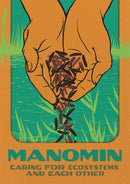Description
Edited by Brittany Luby, Margaret Lehman, Andrea Bradford, Samantha Mehltretter and Jane Mariotti. Brittany Luby is an historian and educator whose paternal ancestors originate from Niisaachewan Anishinaabe Nation.
Manomin, more commonly known by its English misnomer “wild rice,” is the only cereal grain native to Turtle Island (North America). Long central to Indigenous societies and diets, this complex carbohydrate is seen by the Anishinaabeg as a gift from Creator, a “spirit berry” that has allowed the Nation to flourish for generations. Manomin: Caring for Ecosystems and Each Other offers a community-engaged analysis of the under-studied grain, weaving together the voices of scholars, chefs, harvesters, engineers, poets, and artists to share the plant’s many lessons about the living relationships between all forms of creation.
Grounded in Indigenous methodology and rendered in full colour, Manomin reveals and examines our interconnectedness through a variety of disciplines—history, food studies, ethnobotany, ecology—and forms of expression including recipes, stories, and photos. A powerful contribution to conversations on Indigenous food security and food sovereignty, the collection explores historic uses of Manomin, contemporary challenges to Indigenous aquaculture, and future possibilities for restoring the sacred crop as a staple.
In our time of ecological crisis, Manomin teaches us how to live well in the world, sustaining our relations with each other, our food, and our waterways.
Manomin, more commonly known by its English misnomer “wild rice,” is the only cereal grain native to Turtle Island (North America). Long central to Indigenous societies and diets, this complex carbohydrate is seen by the Anishinaabeg as a gift from Creator, a “spirit berry” that has allowed the Nation to flourish for generations. Manomin: Caring for Ecosystems and Each Other offers a community-engaged analysis of the under-studied grain, weaving together the voices of scholars, chefs, harvesters, engineers, poets, and artists to share the plant’s many lessons about the living relationships between all forms of creation.
Grounded in Indigenous methodology and rendered in full colour, Manomin reveals and examines our interconnectedness through a variety of disciplines—history, food studies, ethnobotany, ecology—and forms of expression including recipes, stories, and photos. A powerful contribution to conversations on Indigenous food security and food sovereignty, the collection explores historic uses of Manomin, contemporary challenges to Indigenous aquaculture, and future possibilities for restoring the sacred crop as a staple.
In our time of ecological crisis, Manomin teaches us how to live well in the world, sustaining our relations with each other, our food, and our waterways.


